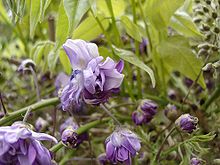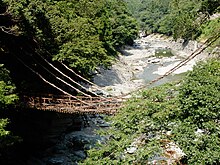Japanese wisteria
| Japanese wisteria | ||||||||||||
|---|---|---|---|---|---|---|---|---|---|---|---|---|

forming a long pergola , in full bloom |
||||||||||||
| Systematics | ||||||||||||
|
||||||||||||
| Scientific name | ||||||||||||
| Wisteria floribunda | ||||||||||||
| ( Willd. ) DC. |
The Japanese Wisteria ( Wisteria floribunda ), mostly Japanese wisteria called, is a plant of the genus Wisteria . It was brought from Japan to the United States by George Rogers Hall in 1860 . Since then, it has become a popular ornamental plant for parks and gardens. The Japanese wisteria prefers moist soils and direct sun.
description
The Japanese wisteria is a deciduous, woody climbing plant ( liana ). The many strong, right-winding trunks can be over 30 meters long. The plant often reaches an age of over 50 years. The alternately arranged, glossy dark green, unpaired pinnate leaves are 10 to 30 centimeters long and consist of nine to 13 leaflets. The elongated, entire leaflets are 2 to 6 centimeters long.
The flowering behavior of the Japanese Wisteria is probably the most spectacular of all species of the genus Wisteria : At 0.3 to 0.9 meters, it has the longest racemose inflorescences of all Wisteria species with many flowers. The flowering period is mainly between early and mid-spring. The early flowering period of the Japanese wisteria can be problematic in temperate climates, as late frost can destroy the budding inflorescences. In addition, this wisteria only blooms after it has passed through the youth stage, which, like the Chinese wisteria from the same genus, can take many years.
Depending on the variety, the white, purple or blue flowers give off a distinctive scent similar to grapes . The fragrant and decorative, hermaphrodite, five-fold flower is zygomorphic and 1.5 to 2.0 centimeters long. The five tips of the overgrown-leaved calyx are unequal. The five petals are purple to blue or white, depending on the variety. The flag is large and vertical. The wings are sickle-shaped. The wings are not fused with the shuttle.
Numerous gray-velvet, bean-like, poisonous legumes are formed, which ripen in summer and remain hanging until spring; they are 10 to 15 cm long. When exposed to strong sunlight, they open with a bang and throw the wrinkled, flat seeds into a greater distance.
Varieties of Wisteria floribunda (selection)
- Alba - white flowers
- Carnea - flesh-colored pink flowers
- Issai Perfect - white flowers when the plant is still young
- Ivory Tower - numerous, fragrant, white flowers
- Lawrence - blue flowers, hardy variety
- Longissima - slightly purple flowers, very long clusters
- Longissima Alba - white flowers in clusters up to half a meter long
- Macrobotrys - reddish-purple flower clusters, a meter or more long
- Macrobotrys Cascade - white and pink-purple flowers, vigorous growth
- Plena - double, blue flowers in dense clusters
- Praecox - blue-violet flowers, dwarf variant
- Purpurea - purple flowers
- Rosea - pale pink flowers with purple tips, 45 cm long
- Royal Purple - purple flowers
- Rubra - intense pink to red flowers
- Snow Showers - white flowers with a lilac tint
- Texas Purple - purple flowers while the plant is young
- Violacea Plena - double, purple, rosette-shaped flowers
use
Wisteria is used almost exclusively as an ornamental plant in Europe . The poison in the seeds is not thermally stable; cooking or roasting makes them edible. The taste of roasted seeds is reminiscent of chestnuts. Young shoots and flowers are also used cooked, sometimes as a tea substitute. Ropes and sandals are made from the bark, and the wood is also processed. In the Japanese Iya Valley ( Tokushima Prefecture ), bridges were built from the plant's spiral shoots to cross rivers . For this purpose, the lianas were braided together after they had reached a sufficient length and wooden planks were added.
More pictures
swell
The article is based on the following documents:
- Japanese Wisteria at MSU. (English)
- Japanese wisteria as "weed". (English)
- University of Ohio datasheet on the genus Wisteria . (English)
Individual evidence
- ↑ a b Wisteria floribunda at Plants For A Future
- ↑ The Vine Bridges of Iya Valley , Atlas Obscura; Accessed: January 12, 2013 (English)
Web links
- Variety descriptions. (German; PDF file; 29 kB)
- Thomas Meyer: Data sheet with identification key and photos at Flora-de: Flora von Deutschland (old name of the website: Flowers in Swabia )







